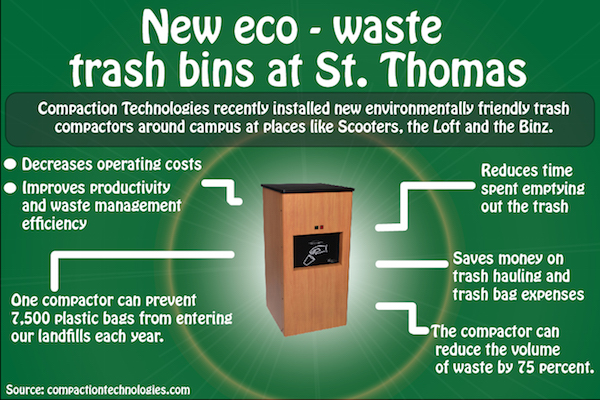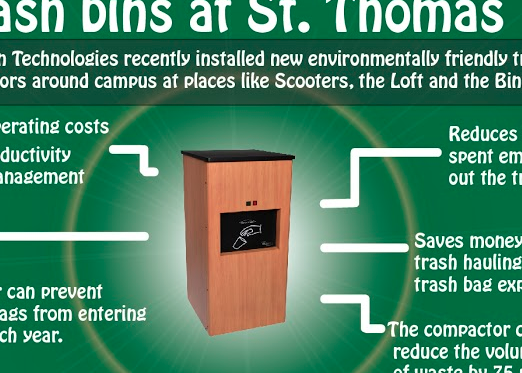
St. Thomas entered into a trial period with Compaction Technologies on April 1, when new trash compactors were placed in the areas that generate the most trash on campus – the Anderson Student Center and the Binz.
Compaction Technologies found its way to St. Thomas through one of the company’s interns, sophomore Bob Buckley. He said he saw a need for the compactors around campus.
“Seeing nine trash cans in Scooter’s before when they were changing them twice a day – that’s a lot of plastic instead of just bringing it down to one bag,” Buckley said. “The compactors do the work of what nine trash cans can do in one day.”
According to Compaction Technologies, this new technology can compact at a rate of 8:1, meaning workers would pull out eight traditional trash bags to one Compaction Technologies Compacted Trash Bag. Bob Guggisberg, director of Facility Services, said these new compactors will save more than just money.
“In these areas, especially food service areas, the old containers were being emptied anywhere from nine to 16 times a day. We are now changing out the liners and pulling out the trash one to two times a day,” Guggisberg said. “In turn, each unit will save five to six thousand plastic bags from hitting a landfill each year. That’s huge.”
These new innovative compactors help save money and labor time, and they also help St. Thomas begin a single-sort recycling program, according to Guggisberg.
“We are looking to go to single sort recycling this summer, so there will be no more segregating plastic, paper and cardboard,” Guggisberg said. “Everything will be going into one, leaving here and going to another site and being sorted there.”
Guggisberg explained that the university was on the forefront of recycling and had a great program 20 years ago.
“It’s just time to re-look at our recovery and see how we compare to everyone else,” he said.
The compactors, which cost a typical cafeteria $8 per year in electrical expenses, also have the most up-to-date technology.
“There’s a capability on them that allows it to communicate with a smartphone,” Guggisberg said. “If we choose in the future to have a smartphone that is carried by building service workers, these units will talk to the phone and tell it when they are full and when to come and take them.”
If St. Thomas agrees to go beyond the trial, the units would be on a lease program, so the company that manufactures them would do all of the maintenance.
“Right now, I think they’re talking about the Minneapolis campus and bringing a few over there,” Buckley said. “They want to try them in the residence halls and maybe the AARC. Generally places where you’re going to be emptying trash three or four times a day because at that point it’s actually saving money.”
St. Thomas is not the only university considering this new green initiative. Minneapolis Community and Technical College and Washington University in St. Louis also have compactors.
Buckley said he’s noticed that students enjoy using the compactors when recycling.
“The biggest thing I’ve seen is people smiling when they throw their trash away,” Buckley said. “It’s pretty great to see that happening because of these trash cans.”
Eric Bromback can be reached at brom0030@stthomas.edu.

